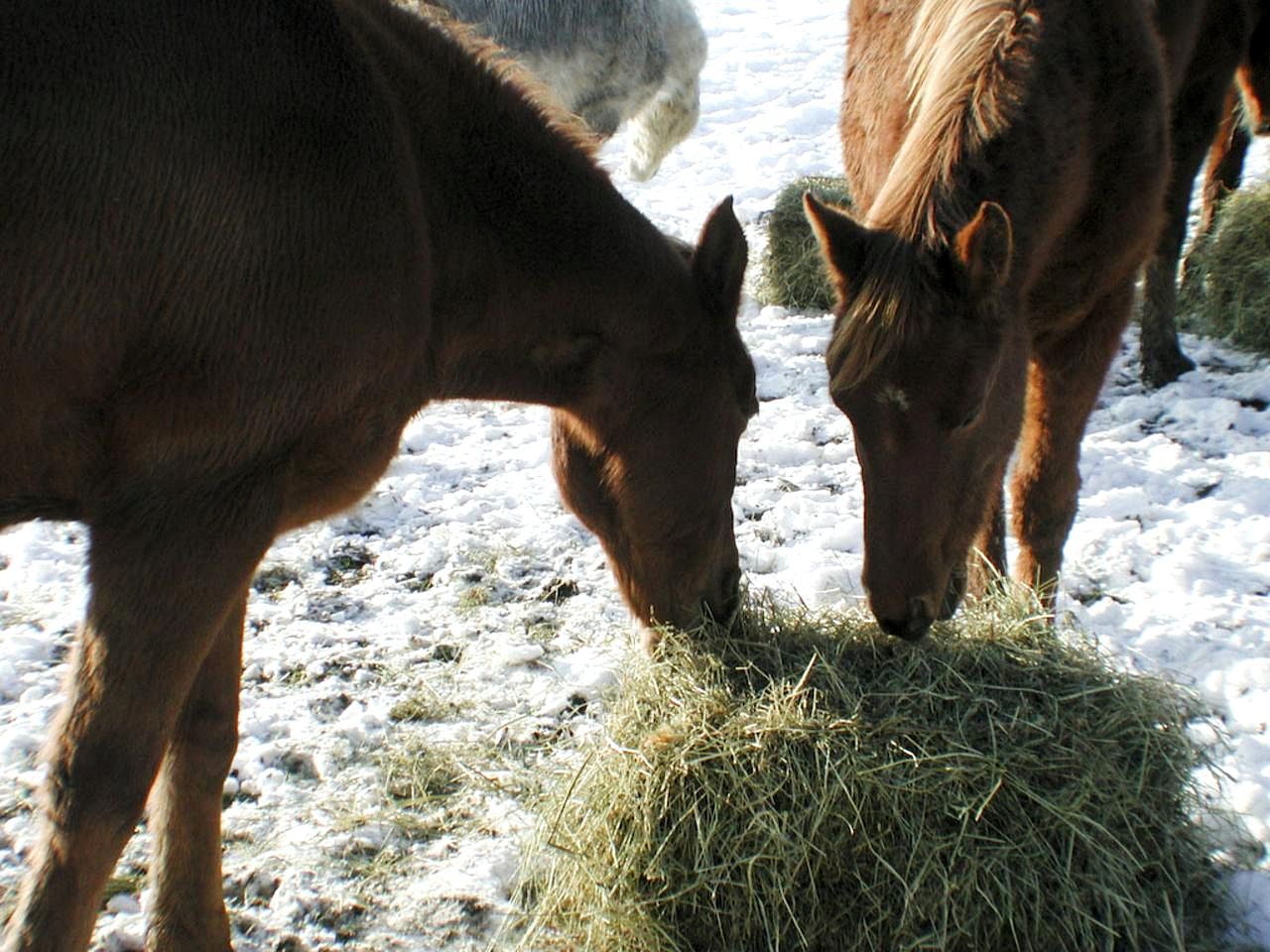This article appears courtesy of the Horse Industry Association of Alberta
Even though most of our horses will eat whatever we put in front of them, all hay is not created equal and there are a number of things to consider when selecting it. Following are some general considerations for selecting hay.
All hay should be free of dust and mold. Horses can develop permanent lung damage after consuming moldy or dusty hay. This chronic condition, commonly referred to as heaves, affects the horse’s ability to breathe normally during exercise and, in severe cases, at rest. In addition, once a horse has been sensitized, it may react to clean feed and will require its hay to be soaked, or substituted with another type of forage. In some cases, mold can also cause digestive upset.
Mold can be present from baling hay that was too moist or it can result from outside moisture getting into the bales after baling. The mold that develops in hay that has too high a moisture level can be more difficult to see but is just as dangerous to the horse, even more so due to its tiny particles which are easily airborne and inhaled. This type of mold will often appear as just a white-ish dust that will come from the hay when dropped or shaken.
What to look for – Hay that doesn’t appear dusty when it is pulled from the bale and shaken.
 Mold that develops from external moisture will sometimes be visible on the outside of the bale. Hay that is stored uncovered or is covered by tarps with holes or tears will often exhibit some of this type of mold. Don’t buy this hay. If you
Mold that develops from external moisture will sometimes be visible on the outside of the bale. Hay that is stored uncovered or is covered by tarps with holes or tears will often exhibit some of this type of mold. Don’t buy this hay. If you

sustain moisture damage to hay you have already purchased, it may be possible to salvage the portion of the bale that was not water-damaged but the rest should not be fed to horses. This type of mold is normally easy to see and will smell musty.
What to look for – Hay that has been stored under cover and doesn’t have white moldy areas on the top, bottom or sides, or dark streaking indicating potential internal water damage.

There are some weeds that are quite palatable to the horse and completely safe, but there are other common weeds that are unpleasant for the horse to find in his feed, such as thistles, or potentially toxic, like alsike clover. Foxtail is another weed that can cause issues for horses, creating abscesses in their mouths and throats. As a general rule, don’t purchase hay with weeds or other unidentifiable plants.
What to look for – Hay that is free of all weeds and foreign materials.
If you are reading the “hay for sale” ads, it is common to see the term “no rain”. This tends to be a strong selling point for horse owners because of the potential nutrient loss caused by rain. Hay that has been rained on during the drying process will lose its bright green colour and turn more beige or brown, depending on the amount of rain. Although a lot of rain on hay can damage it, for those mature “pasture potatoes” in your field, hay with a little rain can have a lower carbohydrate content and actually be a better feed choice.
What to look for – Hay with a green colour and a fresh smell.
Hay with a higher amount of leaves will have more nutrition than a hay with mostly stems, and is more palatable to the horse.
What to look for – Hay that contains a high percentage of leaf with stems that are not thick and coarse.
On top of these general considerations for all horses we need to ask ourselves the question, “Who am I feeding and what are the nutritional requirements of this horse?” Generally speaking, all horses can be fed a good quality hay as outlined above, but some hays are better for some horses.
Although many horse owners prefer a nice leafy, green, grass/legume mix hay cut just at or before maturity, this hay may be more than what your horse needs. Mature horses that are idle or only lightly working and keep weight on easily, may be better off with a hay that is strictly grass, was baled at a greater maturity and maybe even had a little rain. And, if you can find out when the hay was cut, hay cut early in the morning is also preferable, as the grass has a lower sugar content before photosynthesis occurs during the day. Although a younger, leafier hay is more nutritious and palatable for the horse, a stalkier, more mature hay will still meet many horses’ nutritional requirements and provide them with a little more chewing time. They can eat more of this less nutrient-rich hay without getting fat.
When shopping for hay, the type of hay, how it’s stored and when it was baled can be determined over the phone. The quality of the hay should be inspected on site by cutting open a couple of bales and having a look inside. If you are purchasing round bales, reach as far into a few bales as you can and pull some hay from inside. Check for mold, moisture, dust, insects, colour, weeds and leaf/stem ratio. If you don’t like what you find, and the farmer doesn’t have anything different to show you, walk away and keep shopping. The health of your horses depends on you finding a good quality forage to get them through the coming winter.



